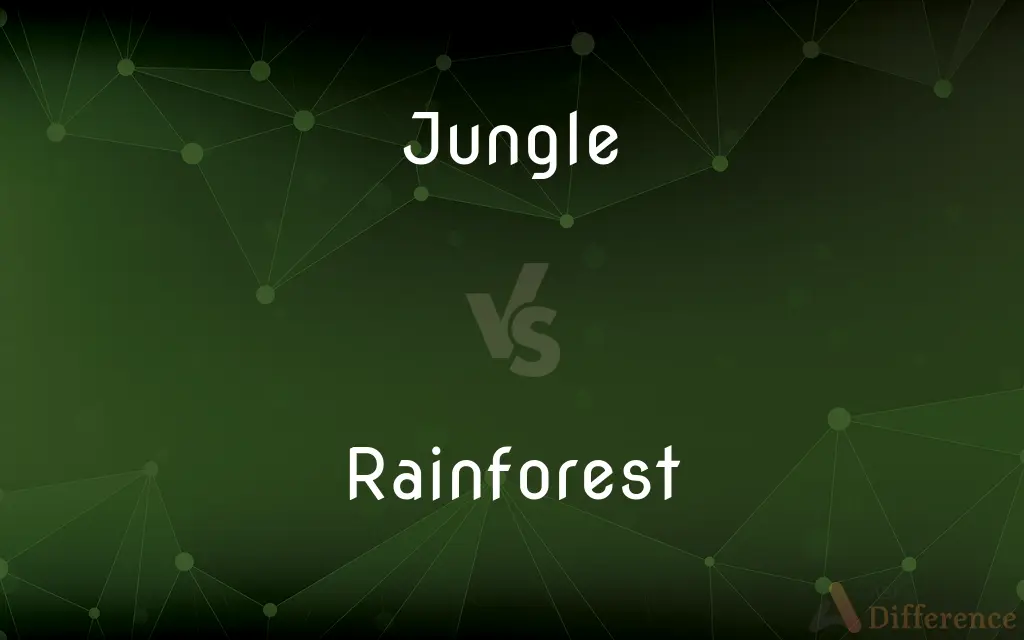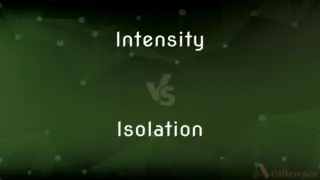Jungle vs. Rainforest — What's the Difference?
By Tayyaba Rehman — Updated on September 8, 2023
Jungle refers to an area with dense, tangled vegetation and wildlife but may lack a tree canopy. Rainforest is a high-rainfall forest with a dense canopy, rich biodiversity, and distinct layers of vegetation.

Difference Between Jungle and Rainforest
Table of Contents
ADVERTISEMENT
Key Differences
Jungle is a term often used to describe a wild, dense, and often tangled area of vegetation that can be found in both tropical and non-tropical regions. Rainforest, on the other hand, specifically refers to forests that are characterized by high levels of rainfall and typically exist in tropical regions.
While jungles can be impenetrable and full of undergrowth, they may lack the dense tree canopy that is a defining feature of rainforests. Rainforests have a complex structure, often described in terms of distinct layers like the emergent, canopy, understory, and forest floor, each with its own unique ecosystem.
The term "jungle" is more flexible and can refer to any wild area, including those in temperate zones, and doesn't necessarily require high levels of rainfall. Rainforests are more specialized environments that are always located in regions with high, consistent rainfall and high humidity.
In popular culture, "jungle" and "rainforest" are often used interchangeably, but they are distinct in ecological terms. A jungle might transition into a rainforest as you move towards regions with higher rainfall, or it might exist at the edges of a rainforest, but they are not the same.
Comparison Chart
Rainfall Requirement
Not necessary
High and consistent
ADVERTISEMENT
Canopy
Often lacking
Dense canopy
Biodiversity
Varied
Extremely high
Layers
Not structured
Structured
Location
Tropical/Non-tropical
Tropical
Compare with Definitions
Jungle
Jungle refers to a wild area with dense, tangled vegetation.
The explorer made his way through the jungle.
Rainforest
Rainforest is a forest characterized by high rainfall.
The Amazon is the world's largest tropical rainforest.
Jungle
Jungle signifies a challenging or confusing situation.
Navigating the legal system felt like a jungle to her.
Rainforest
Rainforest has a dense canopy of tall trees.
Birds flew through the rainforest canopy.
Jungle
Jungle is an area often filled with a variety of wildlife.
The jungle teemed with the sounds of animals.
Rainforest
Rainforest contains distinct layers of vegetation.
Each layer of the rainforest has its own unique ecosystem.
Jungle
Jungle can denote any wild or uncultivated region.
He got lost in the concrete jungle of the city.
Rainforest
Rainforest is home to an extremely high level of biodiversity.
Scientists discover new species in the rainforest regularly.
Jungle
Jungle can represent chaos or lawlessness.
The playground was a jungle of shouting kids.
Rainforest
Rainforest acts as a vital part of the global climate system.
Rainforests are crucial for absorbing carbon dioxide.
Jungle
A jungle is land covered with dense forest and tangled vegetation, usually in tropical climates. Application of the term has varied greatly during the past recent centuries.
Rainforest
Rainforests are characterized by a closed and continuous tree canopy, moisture-dependent vegetation, the presence of epiphytes and lianas and the absence of wildfire. Rainforest can be classified as tropical rainforest or temperate rainforest, but other types have been described.
Jungle
Land covered with a dense growth of tropical vegetation.
Rainforest
A dense evergreen forest with a minimum annual rainfall of approximately 180 centimeters (71 inches). Rainforests are found chiefly in the tropics but also occur in temperate regions, where the rainfall amount is somewhat lower.
Jungle
A dense thicket or growth.
Rainforest
A forest in a climate with high annual rainfall and no dry season.
Jungle
A dense, confused mass; a jumble.
Rainforest
A forest with heavy annual rainfall
Jungle
Something made up of many confused elements; a bewildering complex or maze
Sorting through the jungle of regulations.
Jungle
A place or milieu characterized by intense, often ruthless competition or struggle for survival
The corporate jungle.
Jungle
(Slang) A place where hoboes camp.
Jungle
A large, undeveloped, humid forest, especially in a tropical region, that is home to many wild plants and animals; a tropical rainforest.
Jungle
(South Asia) Any uncultivated tract of forest or scrub habitat.
Jungle
(colloquial) A place where people behave ruthlessly, unconstrained by law or morality.
It’s a jungle out there.
Jungle
(figurative) A tangled mess.
Jungle
(slang) An area where hobos camp together.
Jungle
(UK) A migrant camp.
Jungle
A style of electronic dance music and precursor of drum and bass.
Jungle
A desert region.
Jungle
Dense rough.
Tiger country
Jungle
A hairy vulva.
Jungle
(Of musical beat, rhythm, etc.) resembling the fast-paced drumming of traditional peoples of the jungle.
Jungle
A dense growth of brushwood, grasses, reeds, vines, etc.; an almost impenetrable thicket of trees, canes, and reedy vegetation, as in India, Africa, Australia, and Brazil.
The jungles of India are of bamboos, canes, and other palms, very difficult to penetrate.
Jungle
A place of danger or ruthless competition for survival.
Jungle
Anything which causes confusion or difficulty due to intricacy; as, a jungle of environmental regulations.
Jungle
An impenetrable equatorial forest
Jungle
A location marked by an intense competition and struggle for survival
Jungle
A place where hoboes camp
Common Curiosities
Are Jungle and Rainforest the same?
No, they are different in terms of rainfall, canopy, and biodiversity.
Do Jungles have a canopy?
Not necessarily; jungles often lack a dense tree canopy.
Do Rainforests have layers?
Yes, rainforests have distinct layers like the canopy, understory, and forest floor.
Is a Rainforest always tropical?
Most are tropical, but there are also temperate rainforests.
What is a Rainforest?
A rainforest is a high-rainfall forest with a dense canopy and rich biodiversity.
What is a Jungle?
A jungle is an area with dense, tangled vegetation, often rich in wildlife.
Is Rainforest a technical term?
Yes, it's a term used in ecology to describe a specific type of forest.
How much rain does a Jungle need?
Jungles do not have a specific rainfall requirement.
Which is more biodiverse: Jungle or Rainforest?
Rainforests are generally more biodiverse.
Is a Jungle always tropical?
No, jungles can exist in both tropical and non-tropical regions.
Are Rainforests important for the climate?
Yes, they act as carbon sinks and regulate global climate.
How much rain does a Rainforest need?
Rainforests typically receive at least 98 inches of rain per year.
Is Jungle a technical term?
No, "jungle" is more of a colloquial term and is not strictly defined ecologically.
Can a Jungle be part of a Rainforest?
Yes, jungles can exist at the edges of rainforests.
Do Jungles have high humidity?
Not necessarily, unlike rainforests which are usually humid.
Share Your Discovery

Previous Comparison
Mb vs. Mib
Next Comparison
Intensity vs. IsolationAuthor Spotlight
Written by
Tayyaba RehmanTayyaba Rehman is a distinguished writer, currently serving as a primary contributor to askdifference.com. As a researcher in semantics and etymology, Tayyaba's passion for the complexity of languages and their distinctions has found a perfect home on the platform. Tayyaba delves into the intricacies of language, distinguishing between commonly confused words and phrases, thereby providing clarity for readers worldwide.















































